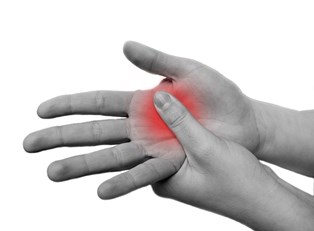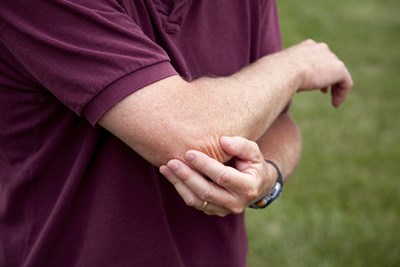Osteoarthritis (degenerative joint disease; osteoarthrosis) is the most common form of arthritis, affecting nearly 21 million Americans. It occurs when cartilage in one's joints degrade over time, usually in the hands, wrists, hips, knees, neck and lower back. Cartilage is a firm, but elastic, material that reduces friction in the joints to serve as a natural shock absorber and is susceptible to damage and degeneration.
Symptoms include joint pain, tenderness, stiffness, locking, and sometimes an effusion (increased fluid). When bone surfaces become more exposed, due to cartilage degeneration, it is susceptible to damage. Painful and stiff joints are consequently used less. The surrounding muscles may atrophy, and ligaments become more lax. No cure exists, but osteoarthritis treatment can relieve pain and help one remain active. Treatment generally involves a combination of exercise, lifestyle modification, and analgesics (pain-relieving drug). In more severe cases, joint replacement surgery may be used to improve quality of life. The chance of developing the disease increases with age, and one should consult a physician if he or she is experiencing swelling and/or stiffness in the joints for more than two weeks. Osteoarthritis diagnosis is based on medical history and clinical examination, usually including x-rays.
Osteoarthritis Causes
Exercise has not been found to increase the risk or be a cause of osteoarthritis. Cracking ones knuckles also does not appear to play a role, though widely believed to be. Some experts believe that mechanical stress on joints underlies all osteoarthritis. When the cartilage that cushions the ends of bones in the joints deteriorates over time, the cartilages smooth surface becomes rough, causing irritation. If the cartilage wears down completely, bone may rub against bone, which damages the ends and causes joint pain. Mechanical stress may underlie all osteoarthritis, so it's important to look at what causes mechanical stress. Researchers suspect it is a combination of factors including the natural aging process, joint injury or stress, heredity, muscle weakness, and obesity. With aging, the water content of the cartilage increases and the protein makeup degenerates. Repetitive use over time irritates and inflames the cartilage, causing pain and swelling. Some individuals are born with abnormally formed joints (congenital abnormalities) that are vulnerable to mechanical wear and tear, causing early degeneration and loss of cartilage. Osteoarthritis of the hip joints is commonly related to such abnormalities present since birth. Hormone disturbances, such as diabetes and growth hormone disorders are also associated with cartilage wear.
Risk Factors of Osteoarthritis Causes
Risk factors of osteoarthritis causes include many different conditions, both natural and sometimes preventable. The disease typically occurs in older adults over forty years of age. Those under forty rarely experience it. Though the cause is unknown, women are more likely to develop osteoarthritis, particularly after the age of fifty-five. Some people are born with malformed joints or defective cartilage. These bone deformities can increase the risk of early joint deterioration. Carrying extra body weight places more stress on the weight-bearing joints. Next to aging, obesity is the most powerful risk factor of osteoarthritis. The early development of osteoarthritis of the knees among weight lifters is believe to be in part due to their high body weight. Certain occupations require the performance of tasks that place repetitive stress on a particular joint. This can predispose the joint toward eventually developing osteoarthritis. Other diseases such as gout, rheumatoid arthritis, Pageti's disease of bone or septic arthritis can increase the risk of developing the disease. Repeated trauma or injury to joint tissues, such as ligaments, bones, and cartilage, is believed to lead to early osteoarthritis in athletes, particularly soccer players. Recent studies have not found an increased risk of osteoarthritis in long-distance runners.



